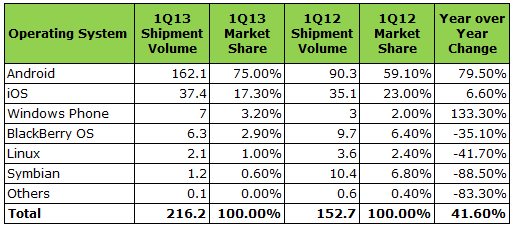My first and (for now) only Android phone was the first Samsung Galaxy S, at that time (a couple of years ago) the hardware specs where not as powerful as they are now, but still Android 2.3 was profiling as very nice mobile operating system.
Today, statistics by IDC show that the market is 75% Android, 17,3% iOS. But this could change very fast.
You can check the Worldwide Mobile Phone Sales to End Users by Vendor in 1Q13 (Thousands of Units) chart on the following link from Gartner.
The problem
Although Android has the big part of the pie, there is a problem with it. All mobile producers, Samsung, HTC, LG, etc. have something in common, none of them provide a phone with the original Android installation, untouched. They all try to differentiate not only in hardware & design, but also on the software customization they offer. Some mobile providers also try to differentiate with the competition by adding their own OS personalization, this makes it even more complicated.
I remember having to wait months for an upgrade to my old Samsung Galaxy S back in Argentina because the Android version that was used, had been modified by Movistar (my carrier there). And because they didn’t work on an upgrade, it was not available for me, at least not through the official channels.
The reason Apple´s iOS is so successful, is because it remains to be simple, everybody (including non-tech people) are able to understand it easily. It also keeps the same overall functionality version after version, so a user could upgrade their phone without having to learn the whole thing again. One of the reasons of their success is because of the closed environment its designed on, limiting how other applications can mess up with the core OS functionalites allows them to provide a stable platform, although of course it has its drawbacks. But in general this makes it easy for users and for developers too.
The only company offering a pure untouched Android installation is Google (the developer of Android). The big benefit for users acquiring the Nexus line is not only that the phone will be unlocked but also they will use the standard Android version on their mobile phones, no customization, no clutter no addons. Also they benefit from receiving the latest updates to the operating system pretty straight forward, like Apple does :).
– Innovation
– Operating system
– Design, usability and general hardware specs.
– Camera quality for pictures and videos.
So, I ask myself, what if a brand, lets say Samsung, decided to leave all the personalization to be chosen by the user? Why not adding all that as a (or several) simple apps or addons? Wouldn’t be great if we could all receive a standard phone and then we could add whatever we need? Then if we don’t like it we could just take it out.
User benefits of doing this
– Users will get the latest version of the available OS almost straight forward.
– Everybody could chose what to install on their phones. They start with a base version and if that fits for them. Enough.
– A standard common interface for all Android phones will make it easy for user to upgrade across brands without the hassle of learning a lot of things again.
– User gets to personalize their device as they are pleased with apps they can download from the Google Play Store.
– Companies could save a lot of money and effort on their software to offer better prices and a better products.
At no point I ever analyze if a mobile manufacturer adds their own applications or software personalization. I could eventually consider an offer like for example the Samsung Galaxy S3 my dad bought came with 2 years of 50GB of Dropbox space for free, that’s a sweet deal.
So my suggestion for all Android mobile producers, invest all the money you put into software personalization, to reduce the costs of the devices. Let the user decide what and how they want to install on their phones and as a benefit everybody will be able to get the latest updates of their mobile OS almost instantly, a lot of users from and a lot of mobile providers will thank you 🙂


You’re forgetting a simple truth in your article: OEMs don’t just customize their products to personalize the experience, they do it to shove their software, and their partners software, down your throat! In their mind it makes sense to create their own little platform separate from the standard android, and reap the rewards. I’m thinking of Samsung especially in this case. What they fail to see is that platform standardization is king!!
João, totally agree with you, that’s why Apple succeeds so much 🙂